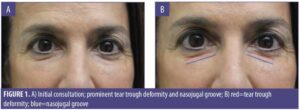I have been performing under eyelid injections for over a decade and I have refined my techniques to minimize the chances that you will develop complications or bruising. That is not to say that complications cannot occur even in the best of hands but with the right techniques the propensity to develop side-effects can be reduced. The most common problem I see with under-eye fillers is when the patient comes back after having had the procedure elsewhere. They may notice nodules, swelling around the eyes, redness, bruising, or even pain.
To reduce the appearance of puffy under eyes after fillers, you need to first understand possible causes for why you developed eyelid swelling. Swelling following under-eyelid fillers most commonly occurs from either using the wrong filler (like highly cross-linked Juvederm) that attracts too much water, placing too much filler into tear toughs (conservative amounts of filler usually does the trick!) and sometimes hematomas (clots of blood) occur especially if the patient is on blood thinners like vitamin E, fish oil, Aspirin, Motrin, Advil and many other medications. Other less frequent causes of puffiness under the eye are from placement of the filler in the wrong location.
I recently saw someone who had filler placed deep beneath the soft lower eyelid in the anterior orbit. Apparently the injector tried to enhance the lower eyelid and the material was injected too deep. Filler in this location can be difficult to remove. The last category are patients who are allergic to Hyaluronic acid (H/A) fillers. In my experience this rarely occurs and can be challenging to treat.

Here is a narrower list of main reasons for swelling and discoloration after injections in the tear trough:
- Technique used by Injector – The injector does not have the correct technique and injects the material too superficially. Understanding the anatomy of the face and understanding the technique for injecting under eyelid filler is critically important.
- Wrong Eyelid Filler Used – The wrong filler was chosen to fill in the lower eyelid hollows. There are “good fillers” and “bad” fillers for the lower eyelids.
- Bleeding – A small amount of bleeding sometimes occurs at the time of injection. This hematoma can cause a hard lump to occur. That may result in your eyelid looking puffy or swollen for several weeks following injections. This can be avoided in many most cases if you prepare well in advance (about 1 week) by stopping vitamin E, fish oil, Aspirin, and Motrin prior to your visit. This will reduce your chances of forming an injection related hematoma. Secondly the injector can help to prevent these events by pre-injecting the area you are getting injections with a numbing agent (lidocaine) mixed with epinephrine which constricts the blood vessels and makes the procedure pain free. In addition the injection should use a blunt needle called a cannula which is less likely to cause bruising.
- Swelling – Temporary swelling may occur if the hyaluronic gel filled the tear trough and technically compresses the surrounding lymphatic vessels which are important for removing fluid build up around the eyes. This is rare for this to occur but occasionally this side effect will happen. No need to worry though because it usually dissipates quickly over 3-4 days.
The Wrong Facial Filler was Used for Under Your Eyes
When picking the best eyelid filler it is important to understand that permanent eyelid fillers should never be used under the eyes. Permanent eyelid fillers include silicone, Radiesse, and Bellafill. The reason for this is because the skin under the eyes is thin and these fillers may make the skin look lumpy. Most importantly they are permanent and cannot be reversed in cases where the outcome is unfavorable.
Sculptra is a semi-permanent filler this is made up of poly l lactic acid. It too may result in nodules beneath the thin lower eyelid skin. It can last years and it too is not reversible, In fact I have had to surgically remove nodules that some patients developed. That is not to say that Sculptra or other permanent or semi-permeant fillers don’t have a role elsewhere on the face but not under the lower eyelids.
So finally what about hyaluronic acid fillers. Well they are off the shelf and don’t require surgery like fat grafts and are reversible. But the hyaluronic filler fillers which are crossed linked like Juvederm and Juvederm Voluma can cause significant swelling. Even though these fillers are hyaluronic acid gels, they are are cross linked and more difficult to sometimes break down with an enzyme called hyaluronidase. I therefore never use Juvederm products under the eyelid area or tear trough.
How about Belotero balance? It is reversible because it is not crossed linked and therefore can be broken down if needed with hyaluronidase. However I am not a big fan of using it under the eyelids because I have seen it cause a Tyndall effect which is blue tint in the eyelid skin.
Best Filler for Tear Trough Injections
My favorite filler for under the eyes is Restylane L not Restylane Defyne or Refyne. These two are cross-linked which causes more swelling post injection. Restylane L has a low propensity to swell and is the ideal hyaluronic filler for the lower eyelid. It is easily reversible with hylaronidase which is rarely needed.
How to Fix Puffiness from Under Eyelid Fillers
Puffiness from under eyelid filler may be a normal but temporary consequence of injections in the tear trough. The reason is the filler may mechanically compress the lymphatic vessels in the lower inner corner of the eyelid which will result in swelling. It can be a source of distress for the patient but in almost all cases this swelling will resolve within a few days. This type of swelling does not require hyaluronidase to dissolve the filler. Patience is key! But if the swelling or puffiness does not resolve then your injector can use hyaluronidase to break-up the hyaluronic acid (H/A) gel. In most cases this will be immediately effective. However, if a heavily cross linked H/A is present sometimes it is difficult to breakdown the filler. It may take multiple sessions with hyaluronidase injections before the filler is dissolved. The last category where intervention may be useful is when a patient develops a hematoma (blood clot). In these cases a steroid injection with Kenalog can help to accelerate the resolution of hematoma.






